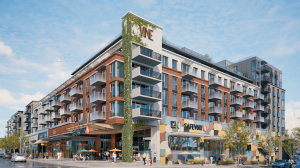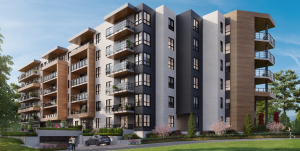VANCOUVER – While North America is pushing to build more using wood, the United Kingdom is running into present-day obstacles but soaring future potential.
Hawkins\Brown Architects senior partner Harbinder Birdi hosted a session titled ãHow Innovation in Timber Construction has Transformed Contemporary British Architectureã at the Wood Solutions Conference in Vancouver. The session looked at how mass timber and other wood technologies are being used to change the face of built forms in the UK.
Birdi said one of the prevailing myths about wood construction in the UK concerns combustibility of materials.
ãI think with the right design team in terms of risk mitigation and understanding where some of the main structural components are, especially load bearing with timber, then we believe itãs a material that can be used and what weãre finding more and more is that a lot of structures are hybrids, so youãll have concrete elements, steel, etcetera, that allow for some stability within the structure and then the timber construction is almost a way of reducing your carbon footprint,ã Birdi said.
The 2017 Grenfell Tower tragedy where 72 people lost their lives after the buildingãs cladding allowed smoke and fire to climb up the towerãs surface has cast a shadow over taller building construction despite having nothing to do with mass timber, Birdi said.
ãWhatãs happened more and more is that developers, regional authorities and commissioning clients are very risk averse when it comes to anything that is flammable since Grenfell. The whole industry, including insurers and build control officers, are very nervous about assuring, approving or accepting designs for buildings that might have combustible components in them,ã he added.
This attitude will prevail over the short term, Birdi added, and people will avoid using combustible material like timber and instead rely on concrete.
ãBut the carbon footprint of concrete is phenomenal, so I think it will take us back a couple of years, but what weãre hoping is weãll be able to somehow integrate timber as a low carbon option, because itãs one of the only ways weãll have a fighting chance of meeting our 2050 targets,ã he said. ô ô
Young people will also want to reduce their carbon footprint, and wood is an excellent material to further that goal, he said.
ãEthically, thatãs where they want to be, and if theyãre becoming vegan, if theyãre flying less, if they have a team of 15 (in a startup), they will be in an office that consumes a low amount of carbon because it is part of their ideology, unlike maybe 20 years ago,ã Birdi said.
Wood also means more up-front planning, which can address labour shortages.
ãThe key thing is very much making sure the client is aware that there needs to be a lot more research, coordination and design with all of the construction and design team up front. Your installation is going to be reduced massively and the bigger challenge at the moment is actually finding people that are willing to work on site,ã Birdi said. ãThe construction industry has a real lack of skilled labour because that is a thing thatãs very mobile. So design it up front, spend more time and invest and get paid for doing the design and that should pay dividends when it comes to assembly and construction.ã
While the construction industry in North America is facing a current and future skill shortage, in England the prospect of a looming Brexit has created its own shortage with free labour movement to and from the European continent about to end.
ãThere is such a skill shortage within the construction industry and with free movement, historically lots of the industry was buoyed by laborers coming from Eastern Europe. These are highly skilled workers and if they arenãt wanted, there isnãt the work, or thereãs other places in Europe with a better offer then those labourers will go there,ã he said.
Brexit has also pushed the industry to adapt and to an extent work around the skills shortage by embracing modular construction.
ãBritish construction companies are now investing in design for manufacture assembly, essentially factories that are able to make components for buildings efficiently without the need for excessive labour,ã Birdi added.
Wood use has also expanded in the UK to the point where design has gone past recognizable ãbareã wood and into different painting and finish treatments, he added.
ãChoose the right finish, but it gets to where everything looks like youãre in a Swedish sauna,ã Birdi joked. ãEvery now and again, it might be right to treat it or paint it.ã











Recent Comments
comments for this post are closed